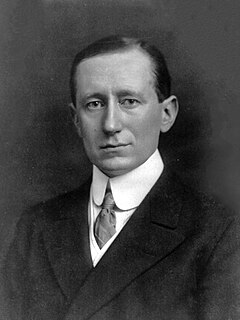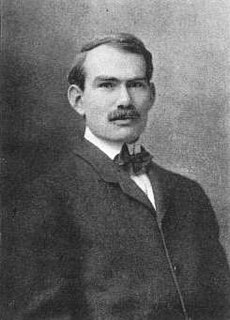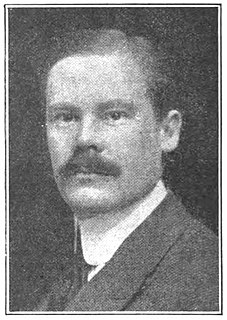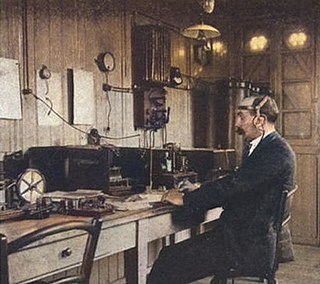
Roy Alexander Weagant (March 29, 1881 - August 23, 1942) was a noted Canadian-American radio pioneer. [1]

Roy Alexander Weagant (March 29, 1881 - August 23, 1942) was a noted Canadian-American radio pioneer. [1]
Weagant was born in Morrisburg, Ontario, and at age 4 moved to Derby Line, Vermont. He attended preparatory school and college in Stanstead, Quebec, then McGill University, Montreal, where he saw demonstrations by Sir Ernest Rutherford, and from which he graduated with a BS degree in 1905. After graduation he worked in turn for the Montreal Light and Power Company, the Western Electric Company in New York City and then Pittsburgh, the General Electric Company at West Lynn, Massachusetts, and in 1907 the DeLaval Steam Turbine Company at Trenton, New Jersey.
When Reginald Fessenden contracted with the company for a steam turbine, Weagant applied for a job, and from 1908 to 1915 worked at Fessenden's National Electric Signaling Company's station at Brant Rock, Massachusetts, working on the design of the 100-kilowatt spark transmitter for the United States Navy's first high-power station at Arlington, Virginia.
In 1915, Weagant joined the Marconi Wireless Telegraph Company of America as a designer, and subsequently became its chief engineer. There he invented the first attempts to avoid infringement of Lee De Forest's audion tube, by means of a Fleming valve with filament and plate. During World War I, Weagant led design of much of the United States Navy's radio equipment.
In 1918 Weagant became famous for "eliminating" static in radio transmissions, inventing the first successful system for reducing its effects, and from 1920 to 1924 was a consulting engineer at RCA attempting to eliminating static, including a winter of 1921–1922 in Bermuda which passed without success. However he did develop directional antennas and other devices that reduced static in transatlantic radio communications. He left RCA in 1924, joining with De Forest in research work, finally in 1925 retired to Lake Memphremagog, Vermont.
He died on August 23, 1942, in Sherbrooke, Quebec. [1]
Some of his papers are now archived in the Lemelson Center, Smithsonian Institution. Weagant served on the Institute of Radio Engineers board in 1914, and was awarded its 1920 IEEE Morris N. Liebmann Memorial Award.

Guglielmo Giovanni Maria Marconi, 1st Marquis of Marconi was an Italian inventor and electrical engineer, known for his creation of a practical radio wave-based wireless telegraph system. This led to Marconi being credited as the inventor of radio, and he shared the 1909 Nobel Prize in Physics with Karl Ferdinand Braun "in recognition of their contributions to the development of wireless telegraphy".
The early history of radio is the history of technology that produces and uses radio instruments that use radio waves. Within the timeline of radio, many people contributed theory and inventions in what became radio. Radio development began as "wireless telegraphy". Later radio history increasingly involves matters of broadcasting.

Wireless telegraphy or radiotelegraphy is transmission of text messages by radio waves, analogous to electrical telegraphy using cables. Before about 1910, the term wireless telegraphy was also used for other experimental technologies for transmitting telegraph signals without wires. In radiotelegraphy, information is transmitted by pulses of radio waves of two different lengths called "dots" and "dashes", which spell out text messages, usually in Morse code. In a manual system, the sending operator taps on a switch called a telegraph key which turns the transmitter on and off, producing the pulses of radio waves. At the receiver the pulses are audible in the receiver's speaker as beeps, which are translated back to text by an operator who knows Morse code.

Reginald Aubrey Fessenden was a Canadian-born inventor, who did a majority of his work in the United States and also claimed U.S. citizenship through his American-born father. During his life he received hundreds of patents in various fields, most notably ones related to radio and sonar.

Lee de Forest was an American inventor and a fundamentally important early pioneer in electronics. He invented the first electronic device for controlling current flow; the three-element "Audion" triode vacuum tube in 1906. This started the Electronic Age, and enabled the development of the electronic amplifier and oscillator. These made radio broadcasting and long distance telephone lines possible, and led to the development of talking motion pictures, among countless other applications.

In radio communications, a radio receiver, also known as a receiver, a wireless, or simply a radio, is an electronic device that receives radio waves and converts the information carried by them to a usable form. It is used with an antenna. The antenna intercepts radio waves and converts them to tiny alternating currents which are applied to the receiver, and the receiver extracts the desired information. The receiver uses electronic filters to separate the desired radio frequency signal from all the other signals picked up by the antenna, an electronic amplifier to increase the power of the signal for further processing, and finally recovers the desired information through demodulation.

Amos Emerson Dolbear was an American physicist and inventor. Dolbear researched electrical spark conversion into sound waves and electrical impulses. He was a professor at University of Kentucky in Lexington from 1868 until 1874. In 1874 he became the chair of the physics department at Tufts University in Medford, Massachusetts. He is known for his 1882 invention of a system for transmitting telegraph signals without wires. In 1899 his patent for it was purchased in an unsuccessful attempt to interfere with Guglielmo Marconi's wireless telegraphy patents in the United States.

Ernst Frederick Werner Alexanderson was a Swedish-American electrical engineer, who was a pioneer in radio and television development. He invented the Alexanderson alternator, an early radio transmitter used between 1906 and the 1930s for longwave long distance radio transmission. Alexanderson also created the amplidyne, a direct current amplifier used during the Second World War for controlling anti-aircraft guns.

An Alexanderson alternator is a rotating machine invented by Ernst Alexanderson in 1904 for the generation of high-frequency alternating current for use as a radio transmitter. It was one of the first devices capable of generating the continuous radio waves needed for transmission of amplitude modulated signals by radio. It was used from about 1910 in a few "superpower" longwave radiotelegraphy stations to transmit transoceanic message traffic by Morse code to similar stations all over the world.

Irving "Al" Gross was a pioneer in mobile wireless communication. He created and patented many communications devices, specifically in relation to an early version of the walkie-talkie, Citizens' Band radio, the telephone pager and the cordless telephone.

The invention of radio communication was preceded by many decades of establishing theoretical underpinnings, discovery and experimental investigation of radio waves, and engineering and technical developments related to their transmission and detection. These developments allowed Guglielmo Marconi to turn radio waves into a wireless communication system.
The timeline of radio lists within the history of radio, the technology and events that produced instruments that use radio waves and activities that people undertook. Later, the history is dominated by programming and contents, which is closer to general history.

The Fleming valve, also called the Fleming oscillation valve, was a thermionic valve or vacuum tube invented in 1904 by English physicist John Ambrose Fleming as a detector for early radio receivers used in electromagnetic wireless telegraphy. It was the first practical vacuum tube and the first thermionic diode, a vacuum tube whose purpose is to conduct current in one direction and block current flowing in the opposite direction. The thermionic diode was later widely used as a rectifier — a device which converts alternating current (AC) into direct current (DC) — in the power supplies of a wide range of electronic devices, until beginning to be replaced by the selenium rectifier in the early 1930s and almost completely replaced by the semiconductor diode in the 1960s. The Fleming valve was the forerunner of all vacuum tubes, which dominated electronics for 50 years. The IEEE has described it as "one of the most important developments in the history of electronics", and it is on the List of IEEE Milestones for electrical engineering.

Alfred Norton Goldsmith was a noted American electrical engineer.

John Vincent Lawless Hogan, often John V. L. Hogan, was a noted American radio pioneer.
The United Wireless Telegraph Company was the largest radio communications firm in the United States, from its late-1906 formation until its bankruptcy and takeover by Marconi interests in mid-1912. At the time of its demise, the company was operating around 70 land and 400 shipboard radiotelegraph installations — by far the most in the U.S. However, the firm's management had been substantially more interested in fraudulent stock promotion schemes than in ongoing operations or technical development. United Wireless' shutdown, following federal mail fraud prosecution, was hailed for eliminating one of the largest financial frauds of the period. However, its disappearance also left the U.S. radio industry largely under foreign influence, dominated by the British-controlled Marconi Wireless Telegraph Company of America.

New Brunswick Marconi Station was located at JFK Boulevard and Easton Avenue just one mile from the New Brunswick border in Somerset, New Jersey.
Broadcasting in the United States began with experiments with wireless transmission during the middle of the 19th century, with varying degrees of success. These transmissions were initially by radio hobbyists fascinated with the technology. Once techniques were perfected, radio became a necessity for military and commercial users alike. Eventually, broadcasting would come to have a major impact throughout the country. Growth divided television broadcasting into several genres, such as fiction, news, sports, and reality television. Cable television provided more channels, especially for entertainment. By the late 20th century radio (sound) broadcasting had similarly divided, with stations specializing in a particular musical genre, or news or sports.
The following timeline tables list the discoveries and inventions in the history of electrical and electronic engineering.

The Marconi Wireless Telegraph Company of America was incorporated in 1899. It was established as a subsidiary of the British Marconi Company and held the U.S. and Cuban rights to Guglielmo Marconi's radio patents. American Marconi initially primarily operated high-powered land and transatlantic shipboard stations. In 1912, it acquired the extensive assets of the bankrupt United Wireless Telegraph Company, becoming the dominant radio communications provider in the United States.